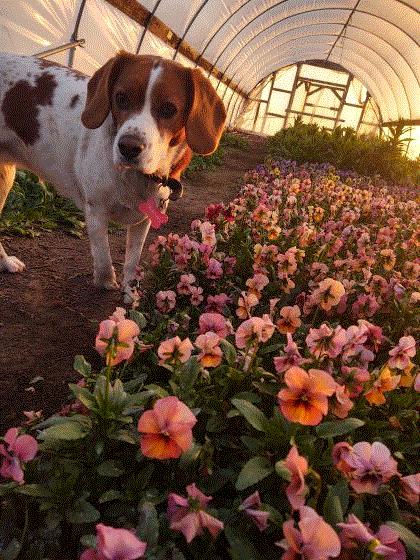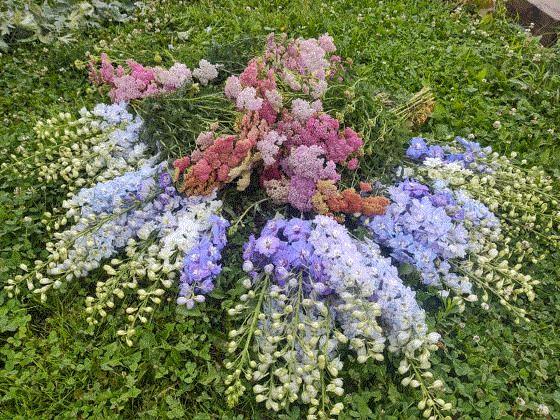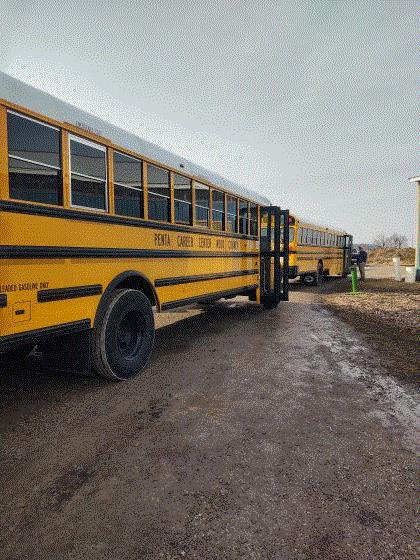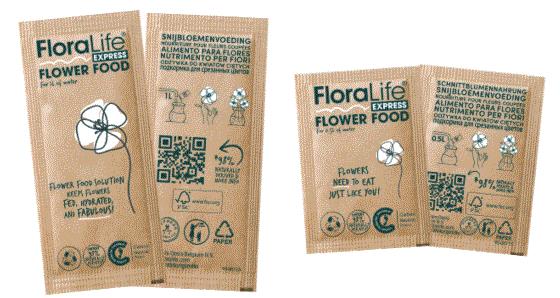End-of-February Farm Update

The pansies are starting to lengthen, a sign that spring is near!
Welcome to the end of February—we hope you all had a banner Valentine’s Day! Tater and I are looking forward to March; the anemone and ranunculus are blooming like crazy and the poppies and pansies will make their first appearance for the season.
Not only are we busy cutting but we are also planning ahead for summer and fall flowers. Tater and I sowed some delphinium and foxglove trays this week. It is recommended to sow delphinium and foxglove approximately 10 weeks before your last frost. Tater and I strive to plant our heat-loving annuals outside right after Mother’s Day (after the threat of frost has passed). After looking at the calendar, we are twelve weeks away from the big holiday, which makes it a perfect time to start thinking about delphinium and foxglove for the season.
Our florists love our foxglove and delphinium crop. Both are showstoppers for florists because quality stems of foxglove and delphinium are difficult to come by on the wholesale market. To be honest, I have yet to see passable foxglove at a wholesale flower distributor in Michigan. The quality of delphinium varies each week, which is why our delphinium fetches a high premium when it is in season.
You can buy plugs for foxglove and delphinium, but we start on our own since we have propagation space. Make sure to weigh your options and determine what volume you want to produce these crops in before jumping headfirst into a sowing frenzy.
In this edition of Bloom Beat we are going to talk abou delphinium, webinars, eco-packaging and more.
With all that being said, let’s talk shop!

Delphinium Primer and Propagation

One of the first bunches of delphinium Guardian Mix from last season. An all-time favorite!
Delphinium is my favorite line flower that we grow on the farm, mostly because of the “wow” you get from your customers when you walk into a shop with an armload of them. Plus, as you know, there are very few true blue flowers in the world, and delphinium is one of them.
The first thing to know about delphiniums is that there are different kinds. ‘Elatum’ delphiniums are taller plants, approximately 30 in. long, with very dense flowers. ‘Guardian’ is a Elatum type delphinium that we grow on the farm. Here is the CULTURE SHEET from PanAmerican seed.
‘Belladonna’ delphiniums are shorter by nature and have more open inflorescences, with single or semi-double flowers. They may not be nearly as showy as their ‘Elatum’ counterparts, but they are incredibly versatile in bouquet work. There is a need for both in the flower business, which is why you should consider growing both. Here is the CULTURE SHEET for ‘Belladonna’ delphinium. Be sure to note the differences between ‘Elatum’ and ‘Belladonna’ types.
If you decide to sow your own delphinium trays, here are a few tips to set you up for success:
According to the Specialty Cut Flower book, written by Alan Armitage and Judy Laushman (now out of print, I believe, but a must-have for your bookshelf), pre-chilled seeds will germinate in 8 to 15 days. Non-chilled seeds will germinate erratically over a three-week period.
Once germinated, grow seedlings cool at 55F and transplant when plants are large enough. You can also take cuttings. If you want to take cuttings off a parent plant, take a 3- to 4-in. cutting of a new shoot, making sure the stem is solid (hollow stem cuttings do not root nearly as well). There are also new fancy varieties, such as ‘Red Lark’ from Darwin Perennials, which is a tissue culture variety that you must buy as plugs.
Plants started early in the spring will flower this season. The flowers the first season won’t be quite as robust. Vernalization is beneficial; blooms will be showier and plants will produce more blooms, but it is not required. The plants will be more productive in their second year.
Based on literature I have read, field-grown crops of the ‘Elatum’ types can yield approximately five stems the first season and ‘Belladonna’ types can produce around 10. They certainly pull their weight the first season! The authors state that in southern states, delphinium are field-planted in the fall for spring flowering and treated as an annual. In northern climates, delphinium plants may be in production for up to three years.
On my farm, we treat delphinium like a short-lived perennial. We only keep a patch in production for three years. We found that the plants lose vigor and become weedy and less productive. That’s why we sow delphinium each season to always have a young patch coming along. Each season we are trying to get better at propagating and sowing delphinium. Hopefully this helps you succeed if you decide to try your hand at growing your own plugs. Keep us POSTED on your progress, or if you have any great tips of your own for Tater and me to try.

Green Career Week is Back!

Earlier this month, we had eighty FFA kids out to the farm.
Tater and I love connecting with the future of the industry!
Seed Your Future’s first annual Green Career Week (GCW), held last fall, was a great success! Tater and I sincerely enjoyed participating, and this week is the spring GCW!
For those of you who are just learning about this great industry outreach initiative, GCW is a national campaign where industry leaders and professionals connect with local high school students to showcase various career paths at their businesses. GCW is from February 27-March 3. For those of you participating this week, Tater and I would love to hear about your experience!
Now if you don’t have a game plan for this week to have students on your farm, no sweat. Reaching out to the future of our industry can take place anytime, not just this week! To be honest, working with high school agriscience teachers in our area is one of the ways we recruit summer help on the farm. Many students and parents simply aren’t aware of our industry, let alone cut-flower farming. It is our responsibility to actively market ourselves and teach young people about what we offer as a career path.
Earlier this month, we had eighty FFA students out to the farm for a tour. The high school had an FFA career day where they visited multiple farms and agri-businesses and Forget Me Not was lucky enough to be the headliner of their tour!
Remember, I mentioned that outreach isn’t limited to one week, so work with your area teachers and students and find a solution that works best with the school’s schedule and your farm. Tater and I showed them around and discussed the challenges and opportunities of running your own farm. They also enjoyed meeting our mini horse, Dierks. I truly enjoy connecting with young students and listening to their future plans and their passions. I can’t stress enough the importance of outreach!
For more information on Seed Your Future and Green Career Week, check out this link. Once again, for those of you who are participating, email us HERE to let us know how it went!

Do or Dianthus Part 2: Success from Rooting to Finishing
The second part of GrowerTalks’ two-art dianthus webinar series will cover all of the production details you need to produce a top-notch dianthus crop, from the first growing stage to shipping.

Gary Vollmer will once again be your guide, this time ably assisted by fellow technical experts James Doukas and Nathan Jahnke, as they bring you the best cultural practices to ensure your success with this crop.
Topics the guys will cover in Part 2 include:
- Scheduling—How to time your production across the different types of dianthus, growing region, growing structures and temperature
- Propagation—Learn the full protocols from receiving the cuttings through to finishing the liners, including mist management, PGRs and more
- Finishing—Pinching, nutrition, temperature, lighting and insect and disease management across different growing systems
Sign up at the GrowerTalks WEBINAR PAGE.
Carbon Neutral Flower Food Packets
Smithers-Oasis is proud to announce that all FloraLife-brand recyclable paper flower food sachets have been determined to be carbon neutral. This includes FloraLife Express, and FloraLife Chrystal Clear products. All packets now are labeled to indicate carbon neutrality and en-of-life recommendations.

In addition, Smither-Oasis is partnering with Carbon Footprint Ltd to offset the remaining carbon footprint for their packets. According to Mark Allen, Global and Sustainability Product Manager for FloraLife, “Not only can consumers enjoy the recyclability of our FloraLife flower food packets, we’ve taken it a step further by making our paper packaging carbon-neutral.”
For more information on Smithers-Oasis’ and their 2025 Sustainability Plan, check out their WEBSITE.
Lindsay Daschner (and Tater)
Editor-at-Large—Bloom Beat
Owner—Forget-Me-Not Farms
This email was received by 6,359 of your fellow fresh-cut flower growers!
If you're interested in advertising in Bloom Beat, contact Kim Brown and she will hook you up!